2014 NISSAN QASHQAI warning
[x] Cancel search: warningPage 26 of 338
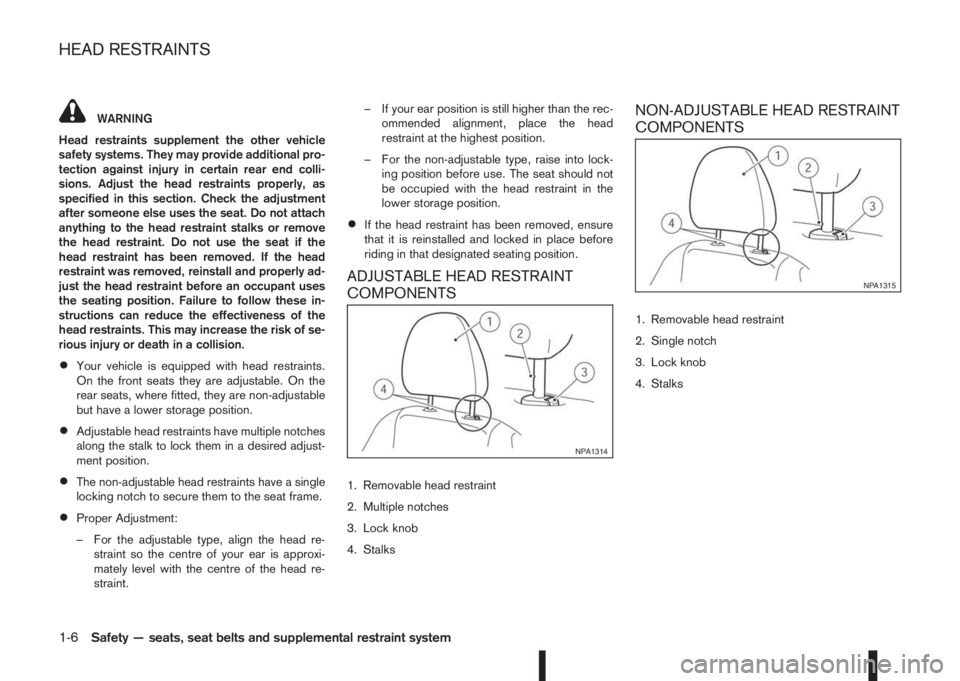
WARNING
Head restraints supplement the other vehicle
safety systems. They may provide additional pro-
tection against injury in certain rear end colli-
sions. Adjust the head restraints properly, as
specified in this section. Check the adjustment
after someone else uses the seat. Do not attach
anything to the head restraint stalks or remove
the head restraint. Do not use the seat if the
head restraint has been removed. If the head
restraint was removed, reinstall and properly ad-
just the head restraint before an occupant uses
the seating position. Failure to follow these in-
structions can reduce the effectiveness of the
head restraints. This may increase the risk of se-
rious injury or death in a collision.
•Your vehicle is equipped with head restraints.
On the front seats they are adjustable. On the
rear seats, where fitted, they are non-adjustable
but have a lower storage position.
•Adjustable head restraints have multiple notches
along the stalk to lock them in a desired adjust-
ment position.
•The non-adjustable head restraints have a single
locking notch to secure them to the seat frame.
•Proper Adjustment:
– For the adjustable type, align the head re-
straint so the centre of your ear is approxi-
mately level with the centre of the head re-
straint.– If your ear position is still higher than the rec-
ommended alignment, place the head
restraint at the highest position.
– For the non-adjustable type, raise into lock-
ing position before use. The seat should not
be occupied with the head restraint in the
lower storage position.
•If the head restraint has been removed, ensure
that it is reinstalled and locked in place before
riding in that designated seating position.
ADJUSTABLE HEAD RESTRAINT
COMPONENTS
1. Removable head restraint
2. Multiple notches
3. Lock knob
4. Stalks
NON-ADJUSTABLE HEAD RESTRAINT
COMPONENTS
1. Removable head restraint
2. Single notch
3. Lock knob
4. Stalks
NPA1314
NPA1315
HEAD RESTRAINTS
1-6Safety — seats, seat belts and supplemental restraint system
Page 28 of 338
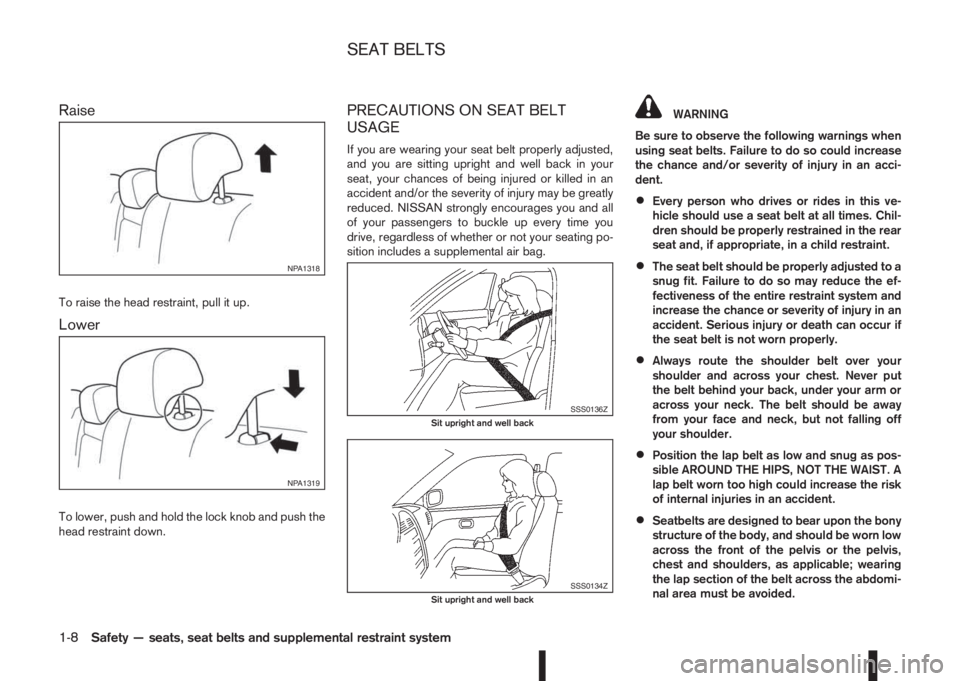
Raise
To raise the head restraint, pull it up.
Lower
To lower, push and hold the lock knob and push the
head restraint down.
PRECAUTIONS ON SEAT BELT
USAGE
If you are wearing your seat belt properly adjusted,
and you are sitting upright and well back in your
seat, your chances of being injured or killed in an
accident and/or the severity of injury may be greatly
reduced. NISSAN strongly encourages you and all
of your passengers to buckle up every time you
drive, regardless of whether or not your seating po-
sition includes a supplemental air bag.
WARNING
Be sure to observe the following warnings when
using seat belts. Failure to do so could increase
the chance and/or severity of injury in an acci-
dent.
•Every person who drives or rides in this ve-
hicle should use a seat belt at all times. Chil-
dren should be properly restrained in the rear
seat and, if appropriate, in a child restraint.
•The seat belt should be properly adjusted to a
snug fit. Failure to do so may reduce the ef-
fectiveness of the entire restraint system and
increase the chance or severity of injury in an
accident. Serious injury or death can occur if
the seat belt is not worn properly.
•Always route the shoulder belt over your
shoulder and across your chest. Never put
the belt behind your back, under your arm or
across your neck. The belt should be away
from your face and neck, but not falling off
your shoulder.
•Position the lap belt as low and snug as pos-
sible AROUND THE HIPS, NOT THE WAIST. A
lap belt worn too high could increase the risk
of internal injuries in an accident.
•Seatbelts are designed to bear upon the bony
structure of the body, and should be worn low
across the front of the pelvis or the pelvis,
chest and shoulders, as applicable; wearing
the lap section of the belt across the abdomi-
nal area must be avoided.
NPA1318
NPA1319
SSS0136ZSit upright and well back
SSS0134ZSit upright and well back
SEAT BELTS
1-8Safety — seats, seat belts and supplemental restraint system
Page 29 of 338
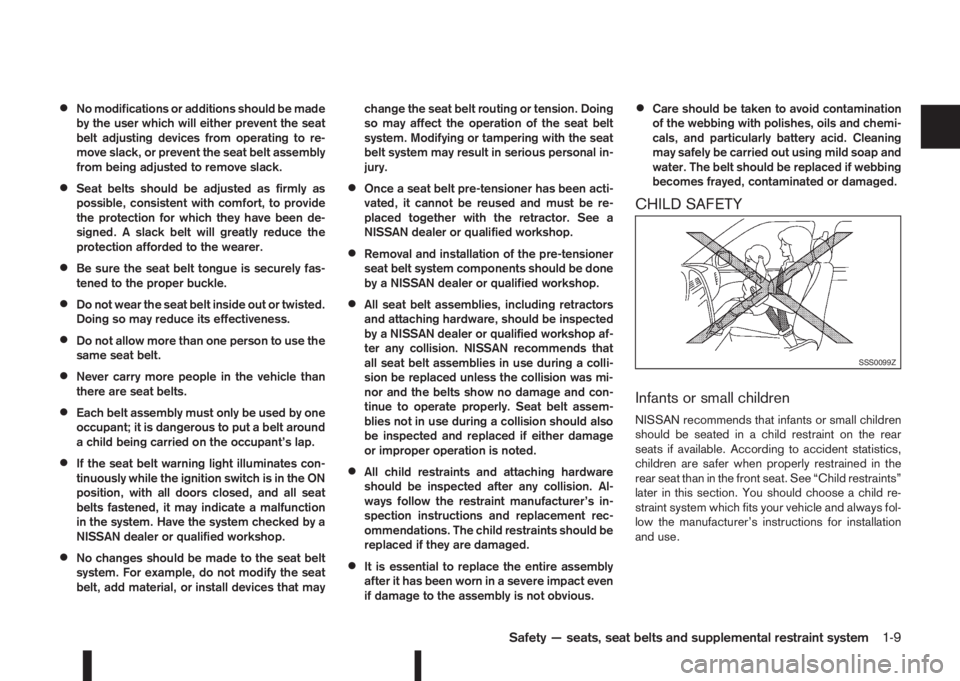
•No modifications or additions should be made
by the user which will either prevent the seat
belt adjusting devices from operating to re-
move slack, or prevent the seat belt assembly
from being adjusted to remove slack.
•Seat belts should be adjusted as firmly as
possible, consistent with comfort, to provide
the protection for which they have been de-
signed. A slack belt will greatly reduce the
protection afforded to the wearer.
•Be sure the seat belt tongue is securely fas-
tened to the proper buckle.
•Do not wear the seat belt inside out or twisted.
Doing so may reduce its effectiveness.
•Do not allow more than one person to use the
same seat belt.
•Never carry more people in the vehicle than
there are seat belts.
•Each belt assembly must only be used by one
occupant; it is dangerous to put a belt around
a child being carried on the occupant’s lap.
•If the seat belt warning light illuminates con-
tinuously while the ignition switch is in the ON
position, with all doors closed, and all seat
belts fastened, it may indicate a malfunction
in the system. Have the system checked by a
NISSAN dealer or qualified workshop.
•No changes should be made to the seat belt
system. For example, do not modify the seat
belt, add material, or install devices that maychange the seat belt routing or tension. Doing
so may affect the operation of the seat belt
system. Modifying or tampering with the seat
belt system may result in serious personal in-
jury.
•Once a seat belt pre-tensioner has been acti-
vated, it cannot be reused and must be re-
placed together with the retractor. See a
NISSAN dealer or qualified workshop.
•Removal and installation of the pre-tensioner
seat belt system components should be done
by a NISSAN dealer or qualified workshop.
•All seat belt assemblies, including retractors
and attaching hardware, should be inspected
by a NISSAN dealer or qualified workshop af-
ter any collision. NISSAN recommends that
all seat belt assemblies in use during a colli-
sion be replaced unless the collision was mi-
nor and the belts show no damage and con-
tinue to operate properly. Seat belt assem-
blies not in use during a collision should also
be inspected and replaced if either damage
or improper operation is noted.
•All child restraints and attaching hardware
should be inspected after any collision. Al-
ways follow the restraint manufacturer’s in-
spection instructions and replacement rec-
ommendations. The child restraints should be
replaced if they are damaged.
•It is essential to replace the entire assembly
after it has been worn in a severe impact even
if damage to the assembly is not obvious.
•Care should be taken to avoid contamination
of the webbing with polishes, oils and chemi-
cals, and particularly battery acid. Cleaning
may safely be carried out using mild soap and
water. The belt should be replaced if webbing
becomes frayed, contaminated or damaged.
CHILD SAFETY
Infants or small children
NISSAN recommends that infants or small children
should be seated in a child restraint on the rear
seats if available. According to accident statistics,
children are safer when properly restrained in the
rear seat than in the front seat. See “Child restraints”
later in this section. You should choose a child re-
straint system which fits your vehicle and always fol-
low the manufacturer’s instructions for installation
and use.
SSS0099Z
Safety — seats, seat belts and supplemental restraint system1-9
Page 30 of 338

Children
Children who are too large for child restraints should
be seated and restrained by the seat belts that are
provided.
The use of a booster seat (commercially available)
may help to avoid the shoulder belt coming across
the face or neck area of a child’s seating position.
The booster seat should raise the child so that the
shoulder belt is properly positioned across the top,
middle portion of the shoulder and the lap belt is low
on the hips. The booster seat should fit the vehicle’s
seat. Once the child has grown so the shoulder belt
is no longer on or near the face and neck, use the
shoulder belt without the booster seat.
WARNING
Never let a child stand or kneel on any seat and
do not allow a child in the cargo areas while the
vehicle is moving.
PREGNANT WOMEN
NISSAN recommends that pregnant women use
seat belts. The seat belt should be worn snug, and
always position the lap belt as low as possible
around the hips, not the waist. Place the shoulder
belt over your shoulder and across your chest. Never
put the lap/shoulder belt over your abdominal area.
Contact your doctor for specific recommendations.
INJURED PERSONS
NISSAN recommends that injured persons use seat
belts, depending on the injury. Check with your doc-
tor for specific recommendations.
SEAT BELT WARNINGS
Driver and front passenger
The seat belt warning lightsj1 , located in the in-
strument panel, will light up if the driver and/or front
passenger seat belts have not been fastened. See
“Warning/indicator lights and audible reminders” in
the “2. Instruments and controls” section for further
details.
Dependant on the vehicle specification the seat belt
warning lights, located in the instrument control
panel, will either:
•Alert only the driver when his/her seat belt is not
securely fastened.
•Alert the driver and/or front passenger when a
seat belt is not securely fastened.
Rear passengers
The rear passenger seat belt warning (where fitted)j1 is shown in the vehicle information display see
“Vehicle information display” in the “2. Instruments
and controls” section.
The seat belt warning alerts the driver and/or front
passenger if a (rear) seat belt is not securely fas-
tened. The seat belt warning shows a filled circle
when the ignition switch is turned to the ON position
and an empty circle when the related seat belt has
been securely fastened, or after approximately 35
seconds after engine start, or when acknowledged
by the driver pushing the steering wheel switch
NOTE
•If there is a change in rear seat belt status
during a journey then the applicable symbol
for any unbuckled seat will show again for a
further 35 seconds.
•The front passenger seat belt warning light
will not illuminate if the seat is unoccupied.
•A chime will sound unless the front passen-
ger seat belt is securely fastened when the
vehicle speed exceeds 25 km/h (15 MPH).
The chime will stop after approximately 90
seconds.
NPA1294
1-10Safety — seats, seat belts and supplemental restraint system
Page 31 of 338
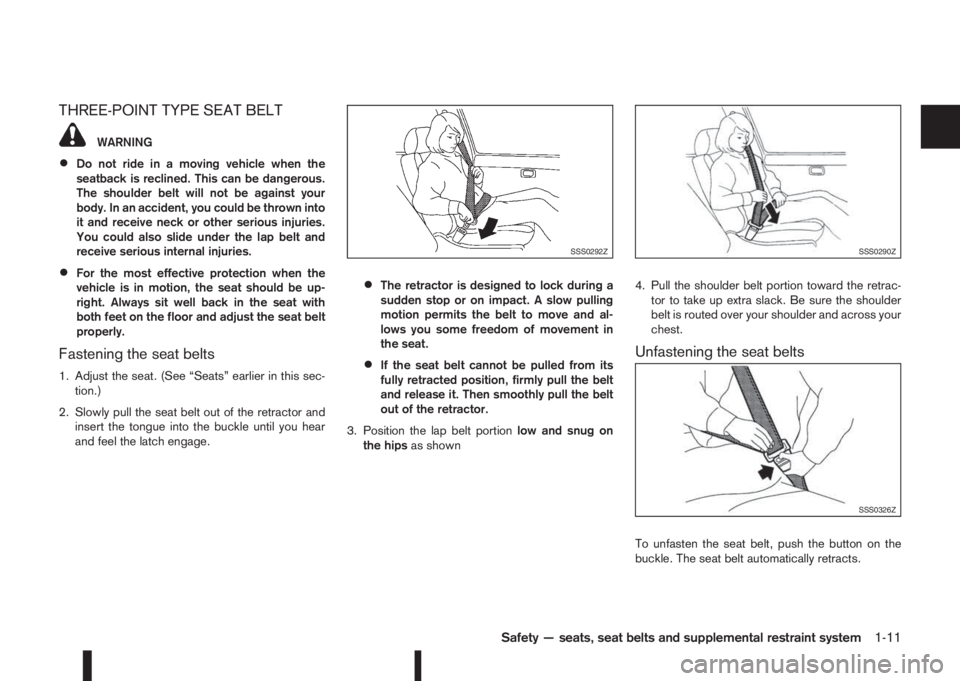
THREE-POINT TYPE SEAT BELT
WARNING
•Do not ride in a moving vehicle when the
seatback is reclined. This can be dangerous.
The shoulder belt will not be against your
body. In an accident, you could be thrown into
it and receive neck or other serious injuries.
You could also slide under the lap belt and
receive serious internal injuries.
•For the most effective protection when the
vehicle is in motion, the seat should be up-
right. Always sit well back in the seat with
both feet on the floor and adjust the seat belt
properly.
Fastening the seat belts
1. Adjust the seat. (See “Seats” earlier in this sec-
tion.)
2. Slowly pull the seat belt out of the retractor and
insert the tongue into the buckle until you hear
and feel the latch engage.
•The retractor is designed to lock during a
sudden stop or on impact. A slow pulling
motion permits the belt to move and al-
lows you some freedom of movement in
the seat.
•If the seat belt cannot be pulled from its
fully retracted position, firmly pull the belt
and release it. Then smoothly pull the belt
out of the retractor.
3. Position the lap belt portionlow and snug on
the hipsas shown4. Pull the shoulder belt portion toward the retrac-
tor to take up extra slack. Be sure the shoulder
belt is routed over your shoulder and across your
chest.Unfastening the seat belts
To unfasten the seat belt, push the button on the
buckle. The seat belt automatically retracts.
SSS0292ZSSS0290Z
SSS0326Z
Safety — seats, seat belts and supplemental restraint system1-11
Page 32 of 338
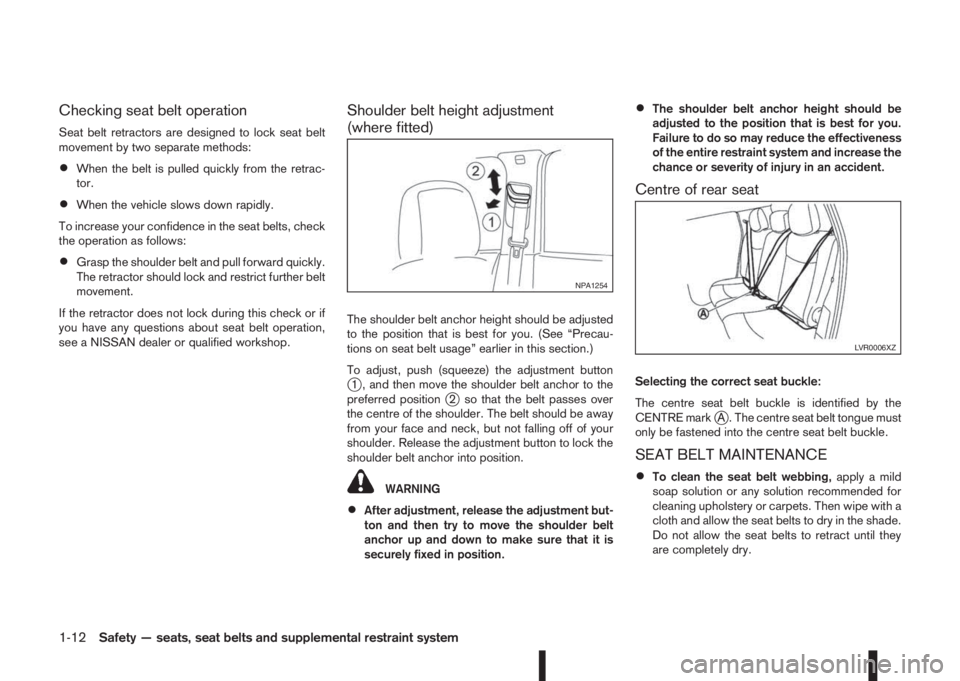
Checking seat belt operation
Seat belt retractors are designed to lock seat belt
movement by two separate methods:
•When the belt is pulled quickly from the retrac-
tor.
•When the vehicle slows down rapidly.
To increase your confidence in the seat belts, check
the operation as follows:
•Grasp the shoulder belt and pull forward quickly.
The retractor should lock and restrict further belt
movement.
If the retractor does not lock during this check or if
you have any questions about seat belt operation,
see a NISSAN dealer or qualified workshop.
Shoulder belt height adjustment
(where fitted)
The shoulder belt anchor height should be adjusted
to the position that is best for you. (See “Precau-
tions on seat belt usage” earlier in this section.)
To adjust, push (squeeze) the adjustment button
j1 , and then move the shoulder belt anchor to the
preferred positionj2 so that the belt passes over
the centre of the shoulder. The belt should be away
from your face and neck, but not falling off of your
shoulder. Release the adjustment button to lock the
shoulder belt anchor into position.
WARNING
•After adjustment, release the adjustment but-
ton and then try to move the shoulder belt
anchor up and down to make sure that it is
securely fixed in position.
•The shoulder belt anchor height should be
adjusted to the position that is best for you.
Failure to do so may reduce the effectiveness
of the entire restraint system and increase the
chance or severity of injury in an accident.
Centre of rear seat
Selecting the correct seat buckle:
The centre seat belt buckle is identified by the
CENTRE mark
jA . The centre seat belt tongue must
only be fastened into the centre seat belt buckle.
SEAT BELT MAINTENANCE
•To clean the seat belt webbing,apply a mild
soap solution or any solution recommended for
cleaning upholstery or carpets. Then wipe with a
cloth and allow the seat belts to dry in the shade.
Do not allow the seat belts to retract until they
are completely dry.
NPA1254
LVR0006XZ
1-12Safety — seats, seat belts and supplemental restraint system
Page 33 of 338
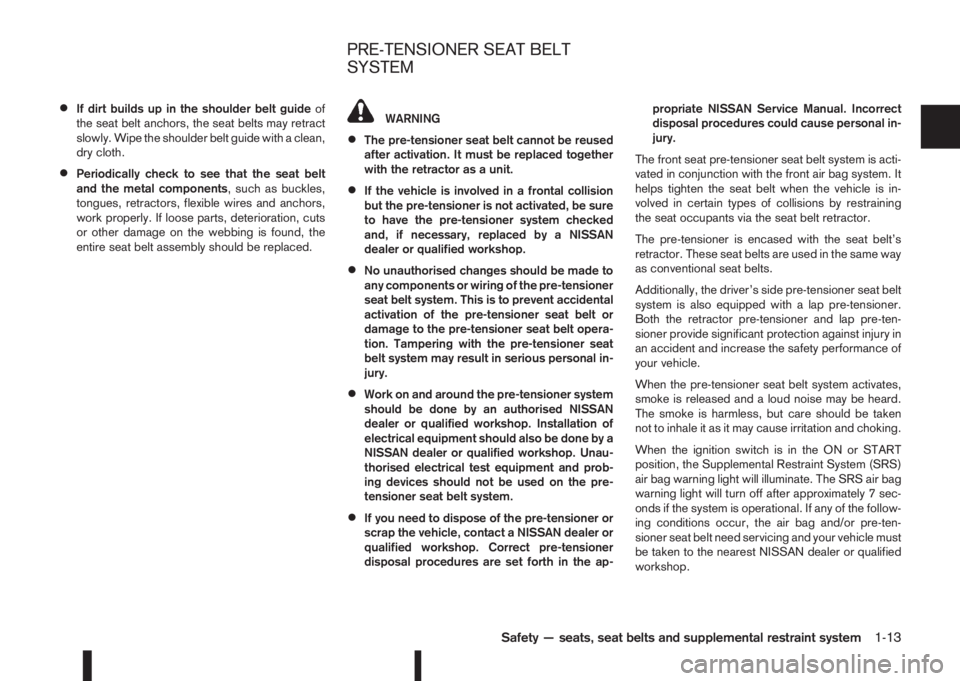
•If dirt builds up in the shoulder belt guideof
the seat belt anchors, the seat belts may retract
slowly. Wipe the shoulder belt guide with a clean,
dry cloth.
•Periodically check to see that the seat belt
and the metal components, such as buckles,
tongues, retractors, flexible wires and anchors,
work properly. If loose parts, deterioration, cuts
or other damage on the webbing is found, the
entire seat belt assembly should be replaced.
WARNING
•The pre-tensioner seat belt cannot be reused
after activation. It must be replaced together
with the retractor as a unit.
•If the vehicle is involved in a frontal collision
but the pre-tensioner is not activated, be sure
to have the pre-tensioner system checked
and, if necessary, replaced by a NISSAN
dealer or qualified workshop.
•No unauthorised changes should be made to
any components or wiring of the pre-tensioner
seat belt system. This is to prevent accidental
activation of the pre-tensioner seat belt or
damage to the pre-tensioner seat belt opera-
tion. Tampering with the pre-tensioner seat
belt system may result in serious personal in-
jury.
•Work on and around the pre-tensioner system
should be done by an authorised NISSAN
dealer or qualified workshop. Installation of
electrical equipment should also be done by a
NISSAN dealer or qualified workshop. Unau-
thorised electrical test equipment and prob-
ing devices should not be used on the pre-
tensioner seat belt system.
•If you need to dispose of the pre-tensioner or
scrap the vehicle, contact a NISSAN dealer or
qualified workshop. Correct pre-tensioner
disposal procedures are set forth in the ap-propriate NISSAN Service Manual. Incorrect
disposal procedures could cause personal in-
jury.
The front seat pre-tensioner seat belt system is acti-
vated in conjunction with the front air bag system. It
helps tighten the seat belt when the vehicle is in-
volved in certain types of collisions by restraining
the seat occupants via the seat belt retractor.
The pre-tensioner is encased with the seat belt’s
retractor. These seat belts are used in the same way
as conventional seat belts.
Additionally, the driver’s side pre-tensioner seat belt
system is also equipped with a lap pre-tensioner.
Both the retractor pre-tensioner and lap pre-ten-
sioner provide significant protection against injury in
an accident and increase the safety performance of
your vehicle.
When the pre-tensioner seat belt system activates,
smoke is released and a loud noise may be heard.
The smoke is harmless, but care should be taken
not to inhale it as it may cause irritation and choking.
When the ignition switch is in the ON or START
position, the Supplemental Restraint System (SRS)
air bag warning light will illuminate. The SRS air bag
warning light will turn off after approximately 7 sec-
onds if the system is operational. If any of the follow-
ing conditions occur, the air bag and/or pre-ten-
sioner seat belt need servicing and your vehicle must
be taken to the nearest NISSAN dealer or qualified
workshop.
PRE-TENSIONER SEAT BELT
SYSTEM
Safety — seats, seat belts and supplemental restraint system1-13
Page 34 of 338
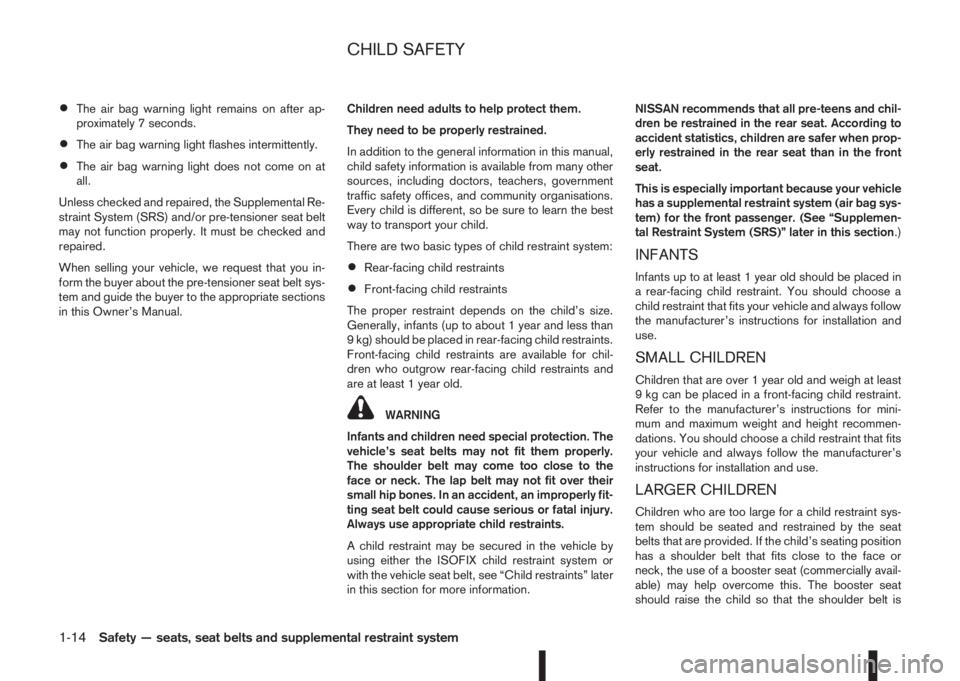
•The air bag warning light remains on after ap-
proximately 7 seconds.
•The air bag warning light flashes intermittently.
•The air bag warning light does not come on at
all.
Unless checked and repaired, the Supplemental Re-
straint System (SRS) and/or pre-tensioner seat belt
may not function properly. It must be checked and
repaired.
When selling your vehicle, we request that you in-
form the buyer about the pre-tensioner seat belt sys-
tem and guide the buyer to the appropriate sections
in this Owner’s Manual.Children need adults to help protect them.
They need to be properly restrained.
In addition to the general information in this manual,
child safety information is available from many other
sources, including doctors, teachers, government
traffic safety offices, and community organisations.
Every child is different, so be sure to learn the best
way to transport your child.
There are two basic types of child restraint system:
•Rear-facing child restraints
•Front-facing child restraints
The proper restraint depends on the child’s size.
Generally, infants (up to about 1 year and less than
9 kg) should be placed in rear-facing child restraints.
Front-facing child restraints are available for chil-
dren who outgrow rear-facing child restraints and
are at least 1 year old.
WARNING
Infants and children need special protection. The
vehicle’s seat belts may not fit them properly.
The shoulder belt may come too close to the
face or neck. The lap belt may not fit over their
small hip bones. In an accident, an improperly fit-
ting seat belt could cause serious or fatal injury.
Always use appropriate child restraints.
A child restraint may be secured in the vehicle by
using either the ISOFIX child restraint system or
with the vehicle seat belt, see “Child restraints” later
in this section for more information.NISSAN recommends that all pre-teens and chil-
dren be restrained in the rear seat. According to
accident statistics, children are safer when prop-
erly restrained in the rear seat than in the front
seat.
This is especially important because your vehicle
has a supplemental restraint system (air bag sys-
tem) for the front passenger. (See “Supplemen-
tal Restraint System (SRS)” later in this section.)
INFANTS
Infants up to at least 1 year old should be placed in
a rear-facing child restraint. You should choose a
child restraint that fits your vehicle and always follow
the manufacturer’s instructions for installation and
use.
SMALL CHILDREN
Children that are over 1 year old and weigh at least
9 kg can be placed in a front-facing child restraint.
Refer to the manufacturer’s instructions for mini-
mum and maximum weight and height recommen-
dations. You should choose a child restraint that fits
your vehicle and always follow the manufacturer’s
instructions for installation and use.
LARGER CHILDREN
Children who are too large for a child restraint sys-
tem should be seated and restrained by the seat
belts that are provided. If the child’s seating position
has a shoulder belt that fits close to the face or
neck, the use of a booster seat (commercially avail-
able) may help overcome this. The booster seat
should raise the child so that the shoulder belt is
CHILD SAFETY
1-14Safety — seats, seat belts and supplemental restraint system